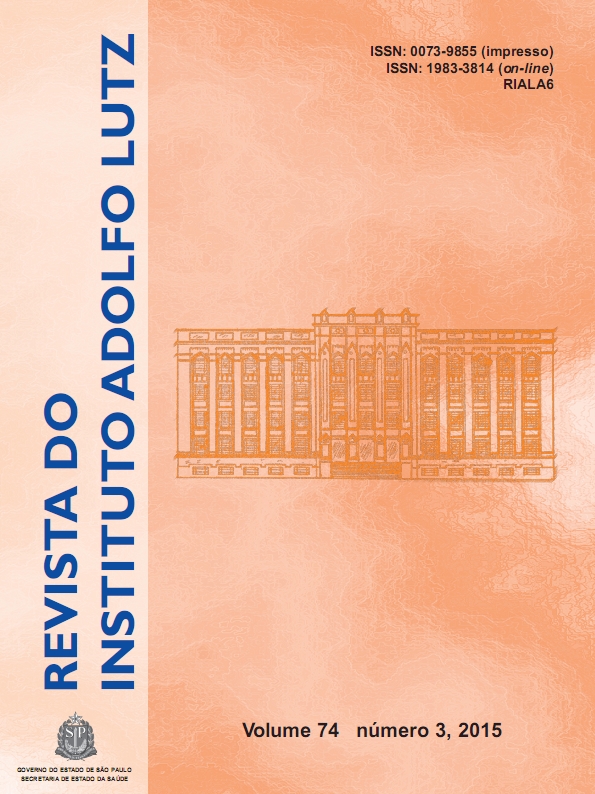Abstract
Campylobacter is the most prevalent etiologic agent of foodborne gastroenteritis worldwide. Although raw milk is an important source of infection, little is known about the consequences of milk recontamination. This study aimed at verifying the viability of Campylobacter jejuni in pasteurized and UHT milks stored under refrigeration. Both samples were divided into five portions of 100 mL, inoculated with 101 CFU.mL-1 of C. jejuni and stored at 4 °C - 7 ºC for 48 h. The procedure was repeated using inoculations of 102, 103 and 104 CFU.mL-1. Aliquots were analyzed immediately after inoculation and after 24 and 48 h to evaluate C. jejuni viability. The microorganism their viability in all of samples. In pasteurized milk a reduction of 1 log cycle occurred after 24 h and low counts after 48 h. Probably, the reduction happened due to the occurrence of microbiota in this milk, which caused competition or inhibition of microorganism growth. UHT milk offered good conditions for bacteria survival in all of the periods. The consumption of contaminated milk, even stored under refrigeration might be a source of infection. Microorganism were more viable in UHT milk than in pasteurized one, probably owing to the absence of competing microorganisms.
References
1. European Food Safety Authority - EFSA. The European Union Summary Report on Trends and Sources of Zoonoses, Zoonotic Agents and Food-borne Outbreaks in 2011. J EFSA.2013;11: 3129 [250 p]. [DOI:10.2903/j.efsa.2013.3129].
2. World Health Organization - WHO. 2012. The global view of Campylobacteriosis. Utrecht, Netherlands, p. 9-11.
3. Esteves WTC, Ferreira AP, Siciliano S. Potencial impacto na Saúde Pública por Campylobacter spp. Estudo de caso: curso inferior do Rio São João, RJ, Brasil. Cad Saúde Colet.2011;19(1):74-81.
4. Silva MR. Investigação epidemiológica de um surto de infecção alimentar por Campylobacter jejuniassociado ao consumo de leite cru [monografia]. Lavras (MG): Universidade Federal de Lavras; 2003.
5. Centro de Informações e Respostas Estratégicas de Vigilância em Saúde - CIEVS. Informe Epidemiológico CIEVS Paraná – Eventos Semana Epidemiológica 10, 2013 [acesso 2015 Fev 13]. Disponível em: [http://www.sesa.pr.gov.br/arquivos/File/ACS/Informe10.pdf ].
6. Gorman R, Bloomfield S, Adley CC. A study of cross-contamination of food-borne pathogens in the domestic kitchen in the Republic of Ireland. Int J Food Microbiol.2002;76(1-2):143–50.
7. Users Guide BAX®System (2007) PCR assay with automated detection for bacterial screening. Du Pont Qualicon, Wilmington, DE.
8. Silva N, Junqueira VCA, Silveira NFA, Taniwaki MH, Santos RFS, Gomes RAR. Manual de métodos de análise microbiológica de alimentos, 3ª Edição, São Paulo: Varella; 2007.
9. International Standards Organization - ISO. ISO 10272-1: Microbiology of food and animal feeding stuffs – Horizontal method for detection and enumeration of Campylobacter spp. – Part 1: detection method. ISO, 2006; ISO 10272-1.
10. Hussain I, Shahid Mahmood M, Akhtar M, Khan A. Prevalence of Campylobacter species in meat, milk and other food commodities in Pakistan. Food Microbiol.2007;24(3):219-22. [DOI: 10.1016/j.fm.2006.06.001].
11. Centers for Disease Control and Prevention - CDC. Outbreak of Campylobacter enteritis associated with cross-contamination of food – Oklahoma. MMWR Surveill Summ.1998;47(7):129-31.
12. Chai LC, Robin T, Ragavan UM, Gunsalam JW, Bakar FA, Ghazali FM, et al. Thermophilic Campylobacter spp. in salad vegetables in Malaysia. Int J Food Microbiol.2007;117(1):106-11.
13. Hazeleger W, Arkesteijn C, Tooropbouma A, Beumer R. Detection of the coccoid form of Campylobacter jejuni in chicken products with the use of the polymerase chain reaction. Int J Food Microbiol. 1994;24(1/2):273-81.
14. Garénaux A, Jugiau F, Rama F, Jonge R, Denis M, Federighi M, et al. Survival of Campylobacter jejuni strains from different origins under oxidative stress conditions: effect of temperature. Curr Microbiol.2008;56(4):293–7. [DOI: 10.1007/s00284-007-9082-8].
15. Moura MS. Influência de crioprotetores e pré-adaptação na viabilidade e produção de transcritos por cepas de Campylobacter jejuni mantidas a -20 ºC [dissertação de mestrado]. Uberlândia (MG): Universidade Federal de Uberlândia, 2013.
16. Advisory Committee on the Microbiological Safety of Food - ACMSF. Second Report on Campylobacter. 2005 [acesso 2014 Abr 16]. Disponível em: [http://www.food.gov.uk/multimedia/pdfs/acmsfcampylobacter.pdf].

This work is licensed under a Creative Commons Attribution 4.0 International License.
Copyright (c) 2016 Instituto Adolfo Lutz Journal
